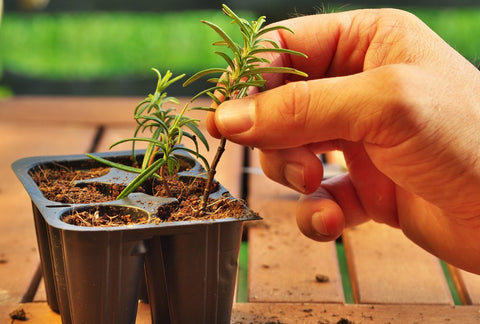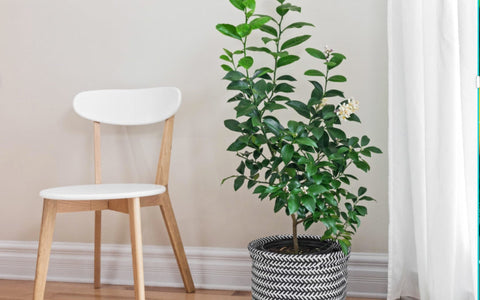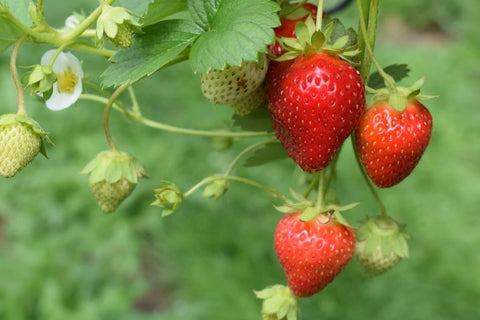Growing fruit trees is a bit different from other indoor edible plants – they’re much bigger, slower-growing, and longer-lived. From potting a live plant to root pruning, there are a few special skills you’ll need. This blog offers a complete guide to all of the gardening activities involved in caring for healthy indoor fruit trees.
How to Plant Your Fruit Trees
The best fruit trees for indoor gardening are grafted, so they can’t actually be grown from seed. (This is why the avocado seed you planted will never give you an avocado.) There are also fruits that grow on bushes – while these can be started from seed, they take years to bear fruit, so we prefer to start with live plants for all fruits.
Your first step is deciding what you want to grow and picking out a cultivar. If you don’t happen to live by a nursery, there are plenty of options online for the best indoor fruit trees – we recommend cultivars & vendors in the “learn by plant” section.
How to Pot Your Indoor Fruit Plants
Potting Bare-Root Plants
Many nurseries ship their indoor fruit plants “Bare-Root” – this means the roots are not in soil and the plant is dormant. It’s a bit strange to receive something that looks like a bare stick, but it’s much easier to make sure you’re not bringing any pests in. After you’ve picked the right container and prepared your soil, you are ready to pot it.

Potting Nursery Container Plants
Most plants purchased in person and online ship in the container they were grown in. Once it arrives, gently pull it out to check on the roots (adding water can help if it’s dry). If they’re not hitting the edge and there’s plenty of soil, then resist the urge to transplant it into a bigger pot. If the roots are crowded and starting to circle around the pot, then you’ll need to repot it. Use a slightly larger pot (2 to 3 inches larger in diameter). Fill the bottom with enough new soil so that the top of the nursery pot lines up with the top of the permanent container. Finish by filling around the edges and watering thoroughly.
Pruning & Shaping
Pruning is important for fruit trees. Even dwarf varieties can easily grow up to 15 feet – and pruning keeps them easier to manage, care for, and fit in our living space. Beyond this, pruning helps the plant focus its energy by limiting the number of branches we allow to develop. The basics of pruning are simple; plants grow from their tips (not the bottom), but if you remove the tip, it will redirect the growth to side branches. The art of pruning takes many forms, such as Bonsai, Espalier, and Spur. We encourage you to explore the look you want, but if you are unsure, open-center pruning is a well-established style for fruit trees.

How to Prune Indoor Fruit Trees with an Open Center
The standard for most indoor fruit trees is known as “Open Center Pruning,” where the canopy consists of 3 or 4 evenly spaced main branches. This lets light and air penetrate through the center and reach the edges for an even, lush plant. Make the first cut when you are happy with the height of the trunk – it may happen as soon as you get your plant (we recommend letting the trunk be at least 2 ft above the soil). This cut should be right above a bud or branch coming off the main trunk. This will encourage the main branches to form, so if more than 3 or 4 come out, remove the extras with an eye to keep spacing even. The main pruning is now done, so just once or twice a year, you’ll want to do a maintenance prune to remove any crossing or dead branches and keep the center short.
The Best Tools for Pruning
A small hand pruner is nice to have when working with fruit trees. While hand or scissors work just fine with most herbs, pruners give you a cleaner cut and are better on tough stems (like trees or woody herbs). We like these Fiskars pruning shears.
Root Pruning & Repotting: It Doesn’t Have to Be Complicated
Note: if you are using an air-pruning pot, you can skip this section.
If your plant is at its desired size, then you want to start an annual root maintenance routine. This helps prevent the roots from taking up all the space in the container and leaving no room for the water, soil, and nutrients that they need! You will want to line this up with pruning the top of your plant by about ⅓ – as the reduced roots could have a hard time keeping up with a “full size” top. Using a sharp knife, cut off 2 inches from the ends of the roots (or ¼ the total length if it’s smaller than 1 foot across). Then place the plant back in the pot with some new, sterile soil and thoroughly water it. Root pruning is an art unto itself – one that bonsai growers have mastered.
It’s Important to Pollinate Your Fruit Trees
All of the indoor fruit trees we recommend are self-fertile, meaning they don’t need pollen from another tree to produce fruit. However, you can get up to 3 times more fruits from the same tree if you pollinate the flowers. We recommend using a paintbrush and just touching the “nose” of each flower on a tree when it is blooming.
The Three Keys to Perfect Fruit: Light, Water, Fertilizer
These are the most critical to your plant's growth, and if you aren’t having success, chances are that one of them is off. We have a complete guide to indoor light as well as recommended containers, watering, and fertilizer schedules. No amount of love can make up for a lack of these elements!









There are no comments for this article. Be the first one to leave a message!